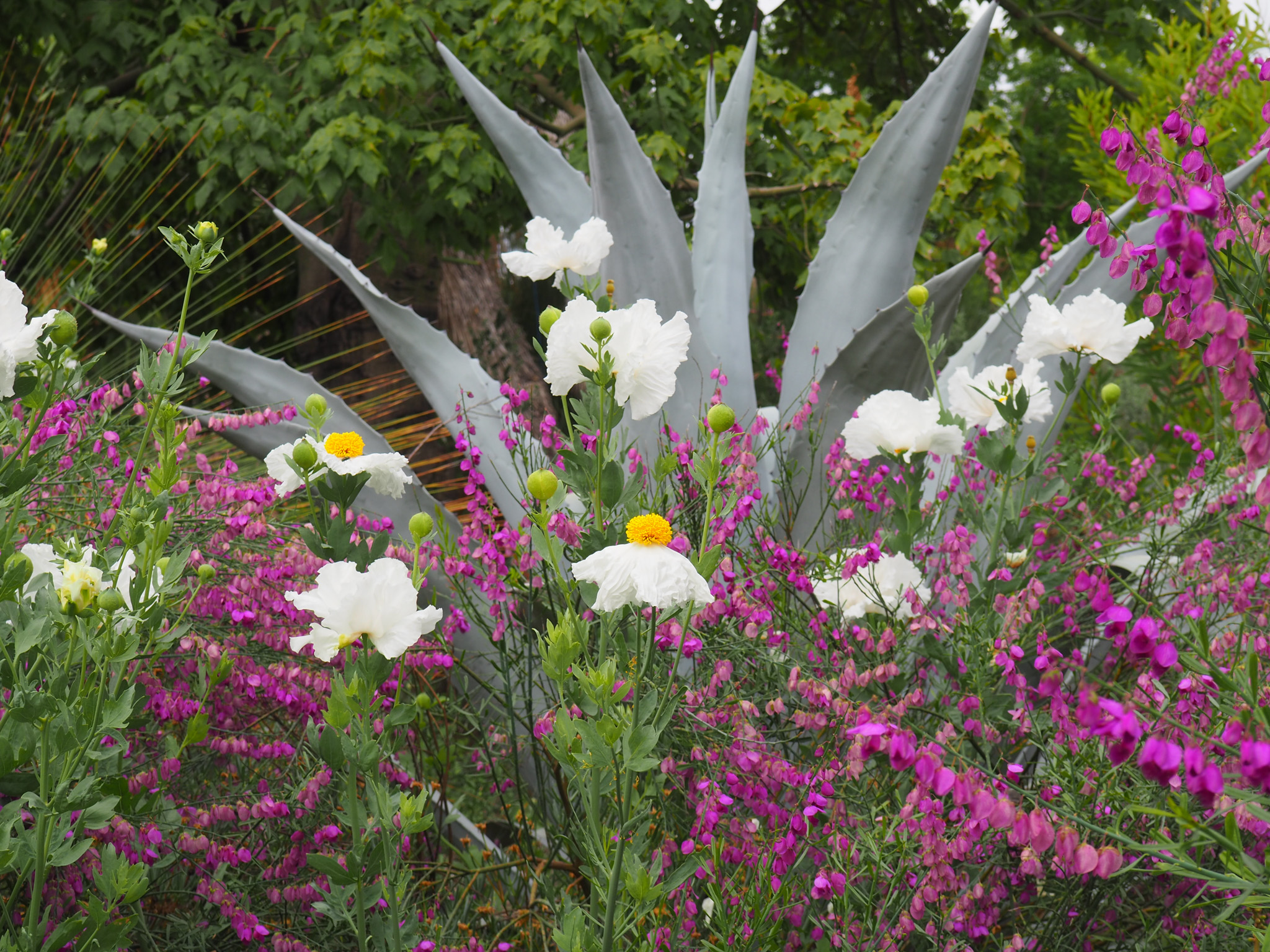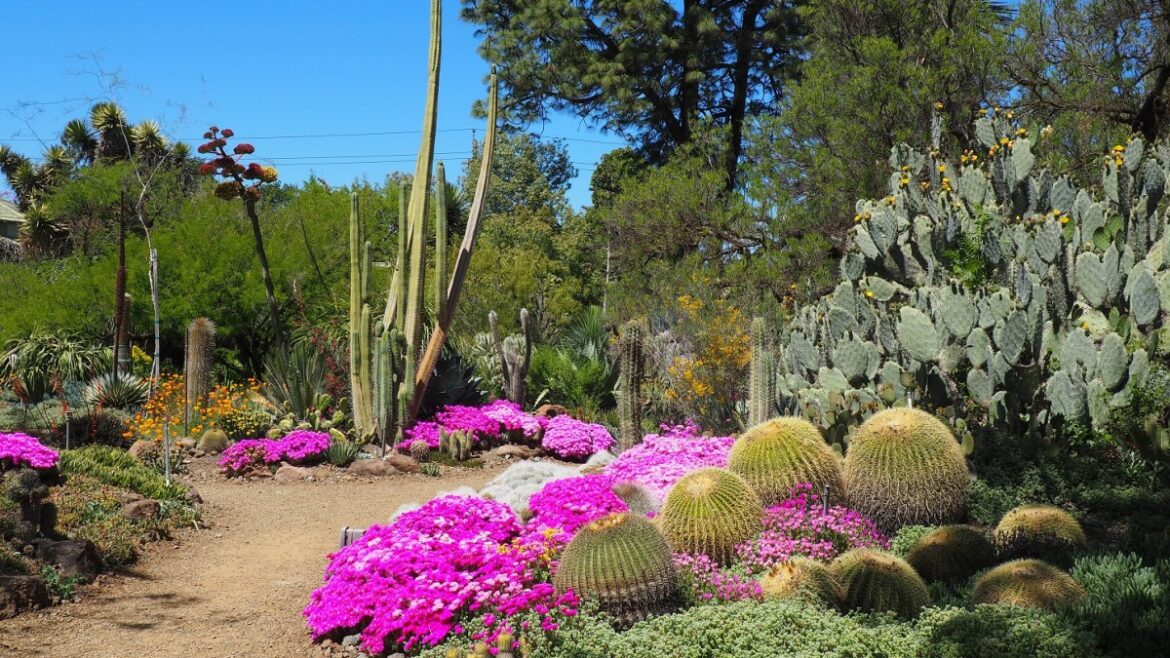This is a story that, even though I now know it well, still seems almost unbelievable. It all began in 1954 when a woman named Ruth Bancroft, the wife of a farmer in a place now called Walnut Creek, just northeast of San Francisco, went to a yard sale in Berkeley. Bancroft was on the lookout for some oriental furniture there but in the end the only thing she went home with was a hybridised aeonium.
These days we have all seen aeoniums but they were highly unusual then. Bancroft, who had been an architectural student, was fascinated by the symmetry of the rosette. This one succulent led to her buying another and another, until she had amassed a few thousand of these fascinating plants, crowded into the greenhouse in the large cottage-style garden she had created around her home in Walnut Creek.

White poppies and purple flowers in the Ruth Bancroft Garden
MONICA AVILA
Fast forward to 1971 when the walnut and pear orchard adjacent to their house had grown so diseased that the trees were removed. “Here’s a big empty field,” her husband, Phil, said to her. “Do you want to use it for your garden?” There was one catch. They would not dig a new well or dip anew into the city water. The new three-acre garden would have to do with minimal water from the existing well.
This is how Bancroft, at the age of 63, decided to create a dry garden before the term had been invented. The aeonium had finally found a home (it was the first plant to go in). She created a series of meandering pathways that led to “rooms”. The beds were all given a topography, with mounds and troughs to replicate natural conditions. Existing trees, such as an old California oak (Quercus lobata) were retained and what became a lifelong global quest for dry garden plants began.
• How to create a living green roof: the expert’s guide
The garden is now famous, a gardener’s garden that truly inspires, especially in our new climate-resilient age. Bancroft, who created this garden for herself, not for glory or fame, died in 2017 at the age of 109 (still gardening until almost the very end). I have wanted to visit it for years and finally did so last month, amused to find it tucked away amid the dull grid of streets and opulent lawns that still mark much of Californian suburbia.

Ruth Bancroft’s garden thrives in the dry Californian heat
MONICA AVILA
I had always thought it would be what I would call a desert garden and imagined it would be an arid space, with spiky and spiny plants, with plenty of space between them. I was thrilled to discover that I was fundamentally wrong. I walked into a magical succulent wonderland with paths weaving between undulating beds that had been planted in layers that enabled you to see the contrasting leaf shapes, textures and colours. Here was a xeriscaped garden that was positively lush.
• Read more expert advice about gardening
I was shocked by the scale. Columnar cacti, soaring high, border the paths. Huge agaves, more than twice my size, were focal points. Aloes were plentiful, varying in height from ground level to more than a metre, with some in bloom. There were flowering shrubs galore, including leucadendron and banksia. The ground was covered in soft succulents, many in bloom, their rosettes providing a geometrical theme throughout the garden.
The old oak is still there, its thick, ridged bark making it look as if clad in alligator hide. Other trees include the bottle tree from Australia with its bulbous trunk and fuzzy pink flowers in the summer, plus palms and yuccas of all shapes and sizes. I had never before seen a floss silk tree (Ceiba speciosa) with its large, almost cartoony, pink flowers that had begun to fall, carpeting the cacti and aloes below.

The garden is home to a wide variety of cacti and succulents
MONICA AVILA
This crazily beautiful tree was an example of what Bancroft called “zonal denial”. She believed in using plants that thrived in her Mediterranean climate but she just couldn’t resist this one, which grows best in tropical and subtropical South America. She covered it in the winter until it grew too big and, exposed to the cold, it began to suffer somewhat. It’s still standing, though, and what a showstopper it is.
This garden is from my occasional series featuring exceptional gardens from around the world. The Ruth Bancroft Garden is open Wed to Sun, 9am to 4pm; entry is £11; ruthbancroftgarden.org
How to get Bancroft’s look
A new book called Designing the Lush Dry Garden, by Cricket Riley, Alice Kitajima and Kier Holmes (Timber Press), features some of Bancroft’s favourite plants including the statuesque Agave franzosinii. It can grow up to 2.5m and has arching light grey-blue leaves, which are toothed with spiny tips. The central rosette dies after flowering (yellow spike), replaced by yellow offsets at the base.
Do you have a gardening question? Ask Ann Treneman
Send your question to gardenquestions@thetimes.co.uk for Ann’s new segment on gardeners’ dilemmas


Comments are closed.